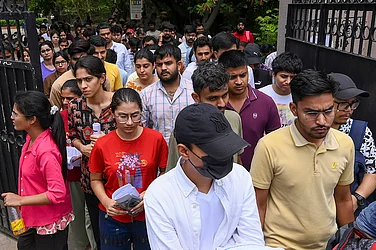Where Leaders Are Made
Education has consistently been regarded as a catalyst for transformation, exemplified by Nelson Mandela’s assertion that “Education is the most powerful weapon which you can use to change the world.” Business schools refine this instrument by cultivating future leaders, entrepreneurs, CEOs, and industry innovators. Business schools provide individuals with a foundation to acquire the essential skills and knowledge required for success in the dynamic and intricate global market.
In India, esteemed institutions such as the Indian Institutes of Management (IIMs), the Indian School of Business (ISB), XLRI – Xavier School of Management, and SP Jain Institute of Management and Research (SPJIMR) have gained prominence. These institutions have cultivated leaders who have ascended to the helm of multinational corporations, shaped public policy, and propelled innovation on both domestic and international fronts. Nonetheless, as the world evolves, the challenges confronting these institutions become increasingly intricate. Business schools must reconcile academic rigour, corporate demands, and changing societal requirements.
As India ascends to the global stage, its business schools must align with international standards while addressing the distinct challenges of the Indian market. They must also contend with emerging technologies, evolving business models, and a progressively interconnected global landscape.
From Harvard to the IIMs: The Journey of Business Schools
The origins of business schools date to the early 20th century, when Harvard Business School launched the MBA in 1908, signifying the beginning of structured management education. John F. Kennedy once remarked, “Leadership and learning are indispensable to each other,” a principle that has guided the mission of business schools since their inception. They serve as centres that cultivate leadership, equipping students with the knowledge and skills to advance organisations in a competitive, globalised economy.
This educational model proliferated from the United States to Europe, establishing prominent institutions such as INSEAD and London Business School (LBS). Shortly thereafter, Asia, especially India, participated in the initiative, founding the inaugural IIM in Calcutta in 1961.
India’s initiative in management education was integral to a comprehensive national strategy aimed at professionalising its industries and enhancing the quality of its workforce. IIM Calcutta, succeeded by IIM Ahmedabad and IIM Bangalore, exemplified the government’s dedication to establishing premier management institutions. These schools were designed after Western institutions but adapted to address the specific challenges of the Indian economy, which was significantly shaped by socialist planning at that time.
As India ascends to the global stage, its business schools must align with international standards while addressing the distinct challenges of the Indian market.
The liberalisation of India’s economy in the early 1990s constituted a pivotal moment, heralding the onset of swift expansion and development for Indian business schools. With India’s liberalisation of foreign investments, trade, and private enterprises, the demand for proficient managers escalated. Business schools were required to enhance and broaden their curriculum to address the needs of a globalised economy. The IIMs grew increasingly competitive, with their graduates in high demand from multinational corporations domestically and internationally.
Concurrently, emerging institutions such as the Indian School of Business (ISB) in Hyderabad, the Management Development Institute (MDI) in Gurgaon, and the Narsee Monjee Institute of Management Studies (NMIMS) in Mumbai introduced more flexible, globally integrated programs. Introducing a one-year MBA program at ISB, designed for mid-career professionals, transformed management education in India. This innovation exemplified the swift transformation of business schools globally, where conventional two-year MBA programs were augmented with specialised, flexible courses tailored for working professionals and entrepreneurs.
What Makes a Business School Stand Out?
The inquiry into the factors contributing to a business school’s success is as ancient as the institutions themselves. Success seldom arises from a singular factor; instead, it is the culmination of various elements that foster an environment conducive to learning, leadership, and innovation. Robert Collier’s assertion, “Success is the sum of small efforts, repeated day in and day out,” succinctly embodies the formula for an exemplary business school. In India, the United States, and Europe, the defining characteristics of a premier institution generally include visionary leadership, curriculum innovation, exceptional faculty, and robust industry connections.
1. Leadership and Governance: Visionary leadership is fundamental to the success of any business school. The deans and directors of these institutions function as academic figureheads and strategic leaders, influencing the future trajectory of their schools. An effective dean must straddle both the academic realm and the corporate domain. They must comprehend the evolving dynamics of global commerce and align their institution accordingly. The deans of institutions such as IIM Ahmedabad, IIM Lucknow, the Faculty of Management Studies (FMS) at Delhi University, and the Jamnalal Bajaj Institute of Management Studies (JBIMS) in Mumbai have been leading their schools with academic distinction and equipping their graduates to confront the challenges of a progressively globalised economy. They reconcile the necessity of upholding stringent academic standards with the imperative of remaining pertinent to the business sector’s requirements. Likewise, Xavier School of Management (XLRI) and Great Lakes Institute of Management in Chennai distinguish themselves in a saturated market by frequently depending on innovative curricula and strategic collaborations with industry. This long-term vision establishes this institution as a frontrunner in academia and industry.

2. Curriculum Innovation: In the contemporary, rapidly changing, technology-oriented environment, business education must perpetually adapt to align with industry requirements. Although conventional disciplines such as finance, marketing, and human resources are essential, business schools must also incorporate courses in emerging fields like artificial intelligence (AI), blockchain, and data analytics. Indian business schools have swiftly adjusted to these transformations. IIM Bangalore has launched specialised programs in data science and business analytics, highlighting the increasing demand for these competencies in the corporate sector. Likewise, the Symbiosis Institute of Business Management (SIBM) in Pune and the T.A. Pai Management Institute (TAPMI) in Manipal have established formidable reputations for their emphasis on entrepreneurship and innovation, offering programs aimed at assisting students in launching new ventures or expanding existing enterprises. Alongside introducing new courses, business schools must reevaluate their educational delivery methods. Digital learning platforms, hybrid educational models, and experiential opportunities such as internships and live projects have become integral elements of contemporary business education. Institutions such as ISB have led this transition by providing flexible, modular programs that enable students to reconcile their academic pursuits with professional obligations.
3. Faculty and Research: A business school’s strength is contingent upon its faculty’s quality. Henry Ford observed, “Anyone who ceases to learn is aged, regardless of being twenty or eighty,” a sentiment particularly applicable in academia. Esteemed faculty contribute extensive experience, knowledge, and research expertise, thereby substantially enhancing the educational quality provided by a business school. India’s premier business schools, including the IIMs, ISB, and Birla Institute of Management Technology (BIMTECH) in Greater Noida, have effectively recruited faculty with academic qualifications and practical industry experience. Integrating theory and practice is crucial for equipping students with a comprehensive education that prepares them for the intricacies of the business environment. Faculty members actively involved in research introduce contemporary insights and advancements into the classroom, ensuring that students acquire fundamental knowledge while being exposed to innovative concepts. Research constitutes an essential element of a thriving business school. Institutions that generate significant research can transform industry standards, affect public policy, and enhance academic leadership. Institutions such as IIM Kozhikode, SPJIMR, and K.J. Somaiya Institute of Management in Mumbai have significantly advanced research in economics, public policy, and corporate governance, reinforcing their status as leaders in the domain.
India’s initiative in management education was integral to a comprehensive national strategy aimed at professionalising its industries and enhancing the quality of its workforce.
4. Industry Connections: The most esteemed business schools uphold robust affiliations with the industry. These connections are essential for multiple reasons. Initially, they offer students opportunities for internships, live projects, and executive education, which are crucial for acquiring practical, hands-on experience. Secondly, industry partnerships frequently result in collaborative research initiatives, enabling faculty and students to address authentic business challenges. Third, robust industry connections align the school’s curriculum with the demands of the corporate sector. In India, business schools such as IIM Indore, IMT Ghaziabad, and the Institute of Management Technology (IMT) Nagpur have established robust affiliations with prominent companies across various sectors, both domestically and globally. These collaborations not only augment the educational experience for students but also bolster the school’s placement statistics, a vital component of its overall success.
The Indian Business School Landscape: Challenges and Opportunities
Peter Drucker observed, “The most effective method to foresee the future is to construct it.” This sentiment is especially applicable to business schools in India, which encounter numerous challenges yet possess considerable growth and innovation opportunities.
1. Insufficient Faculty Resources: A significant challenge confronting Indian business schools is the deficiency of qualified faculty. Although premier institutions can recruit elite educators, numerous smaller or newer schools encounter difficulties. The shortage is partially attributable to the swift proliferation of business education in India, surpassing qualified professors’ availability. Consequently, numerous institutions must depend on adjunct faculty or industry professionals who may lack the requisite academic qualifications to deliver a high-quality education. The deficiency of qualified faculty directly affects the quality of education numerous business schools provide. Without seasoned professors to mentor students in theoretical and practical business principles, graduates may lack the requisite skills and knowledge for success in the corporate arena.
The liberalisation of India’s economy in the early 1990s constituted a pivotal moment, heralding the onset of swift expansion and development for Indian business schools
2. Globalisation and Competition: Indian business schools encounter escalating competition nationally and globally. Amidst more than 4,000 business schools nationwide, there exists a perpetual competition for premier students, faculty, and industry collaborations. Furthermore, Indian institutions are progressively competing with international business schools for students inclined to pursue education overseas. Indian business schools must identify strategies to distinguish themselves and maintain competitiveness. This can be accomplished via curriculum innovation, robust industry collaborations, or an emphasis on specialised fields such as entrepreneurship or rural management. Institutions that establish a distinct identity and provide a unique value proposition will be more effectively positioned to attract elite talent and cultivate a robust reputation in India and internationally.
3. Financial Viability: Operating a business school entails significant costs. Faculty remuneration, infrastructure expenditures, and the necessity for technological investment collectively impose a financial strain on numerous institutions. Although prestigious institutions such as the IIMs and ISB can impose substantial tuition fees and attract corporate sponsorships, numerous smaller schools face challenges in maintaining financial sustainability. Indian business schools must investigate alternative revenue sources to tackle this challenge. Executive education programs, online courses, and corporate partnerships can generate supplementary revenue while improving the institution’s reputation and industry affiliations. Institutions that can innovate their revenue models will be more equipped to navigate financial difficulties and maintain the provision of high-quality education.
4. Digital Transformation: The emergence of digital technologies poses both a challenge and an opportunity for Indian business schools. The growing integration of AI, machine learning, and data analytics in the business sector necessitates educational institutions embed these technologies into curricula. The transition to online learning and digital platforms necessitates substantial investment in infrastructure and technology. Indian business schools have advanced in this domain, with numerous institutions now providing courses on digital transformation and integrating online learning platforms into their curricula. Nonetheless, considerable effort remains necessary to guarantee that students are sufficiently equipped for the digital economy.

Why Rankings Matter: The Role of ICARE Outlook
In business education, rankings are essential in assessing an institution’s success and visibility. Benjamin Franklin once stated, “Without continuous growth and progress, terms such as improvement, achievement, and success lack significance.” This applies to business schools, where their ranking performance frequently assesses advancement and development.
The IIMs grew increasingly competitive, with their graduates in high demand from multinational corporations domestically and internationally
The ICARE Outlook Ranking assesses Indian business schools according to multiple criteria: academic excellence, infrastructure, diversity, and industry affiliations. This ranking offers essential insights for students seeking management education in India, assisting them in identifying institutions that correspond with their career objectives and aspirations.
Achieving a high ranking in systems such as ICARE Outlook provides numerous advantages for business schools. Initially, it enhances visibility, aiding the institution in attracting more students, superior faculty, and robust industry partnerships. Secondly, rankings indicate credibility, conveying to corporate recruiters and industry partners that the institution provides an exceptional education. Third, rankings can assist institutions in obtaining government funding, corporate sponsorships, and international partnerships, which are vital for sustained success.
The ICARE Outlook Ranking’s primary advantage is its ability to showcase not only premier institutions like the IIMs and ISB but also lesser-known schools excelling in specific domains such as entrepreneurship, technology, and rural management. This enables lesser-known institutions to attain recognition and attract students seeking specialised programs that align with their interests.
Leadership Matters: The Role of Deans in Shaping Business Schools
Ralph Nader stated, “The role of leadership is to cultivate additional leaders, not to generate more followers.” In business schools, the roles of deans and directors are pivotal in determining the institution’s trajectory and success. Deans are tasked with establishing the strategic vision of the institution, overseeing its financial management, recruiting faculty, and guaranteeing that students receive an exemplary education.
Deans in India encounter distinct challenges. They must manoeuvre through the intricacies of governmental regulations while simultaneously addressing the demands of the corporate sector. Public institutions such as the IIMs must function within the parameters established by the Ministry of Education. In contrast, private institutions like the Symbiosis Centre for Management and Human Resource Development (SCMHRD) and the Goa Institute of Management (GIM) must devise strategies to distinguish themselves in a fiercely competitive landscape.
Deans establish and sustain relationships with industry partners, alums, and governmental entities. These relationships are crucial for obtaining corporate sponsorships, offering students internship opportunities, and maintaining the curriculum’s relevance to the demands of the business sector.
Influential deans can equilibrate the preservation of academic rigour with the adaptation to the evolving dynamics of the business environment. They must be visionary leaders capable of anticipating the future demands of the business landscape and strategically positioning their institutions to address those demands.
The Future of Indian Business Schools: A Vision for Tomorrow
John Dewey stated, “Education is not preparation for life; education is life itself.” This sentiment illustrates the continual transformation of business schools, especially in India, where institutions must consistently adjust to the demands of a rapidly evolving global business landscape.
Numerous significant trends and challenges will influence the trajectory of Indian business schools. The emergence of entrepreneurship will be pivotal. Government initiatives like “Start-up India” have motivated an increasing number of young professionals to establish their enterprises, necessitating that business schools adapt by providing specialised programs in entrepreneurship and innovation. Institutions such as ISB and IIM Ahmedabad are at the forefront, offering programs to cultivate entrepreneurial aptitude.
Secondly, global networks will be crucial for the future prosperity of Indian business schools. As the business landscape becomes increasingly interconnected, educational institutions must partner with global entities to provide students with international exposure and access to advanced research. Institutions capable of establishing robust international partnerships will be more adept at attracting a diverse faculty and student body, thereby augmenting their global reputation.
The emphasis on sustainability and social impact will increase in significance. The forthcoming generation of business leaders must be equipped to generate profit and foster a more sustainable and equitable world. Business schools that incorporate social responsibility, sustainability, and ethics into their fundamental curriculum will cultivate leaders capable of addressing the most urgent challenges of the 21st century.
Conclusion:
The Road Ahead for Indian Business Schools
Eleanor Roosevelt stated, “The future belongs to those who believe in the beauty of their dreams.” Indian business schools encounter considerable challenges and substantial opportunities as they progress. Through the adoption of innovation, the promotion of entrepreneurship, and the utilisation of global networks, Indian business schools can persist in cultivating exceptional leaders who propel economic and social advancement.
Rankings such as ICARE Outlook will be instrumental in showcasing the premier institutions and facilitating their deserved recognition. The future is promising for business schools that embrace innovation and adaptability. With effective leadership and a clear vision, Indian business schools can influence the future of business education domestically and emerge as global leaders in their own right.
Methodology
The methodology for evaluating business schools in India is a comprehensive framework designed to assess their performance across five critical criteria: Faculty-Student Ratio (25%), Research Output and Impact (20%), Employability of Graduates (25%), Faculty Quality (20%), and Inclusiveness & Diversity (10%). Each criterion is further broken into sub-parameters to provide a detailed assessment of a business school’s strengths.
The Faculty-Student Ratio evaluates access to faculty, while Research Output examines the quantity and impact of research, including publications and contributions to industry practices. Employability focuses on job placements, internships, industry partnerships, and alums outcomes, making it a critical factor for business schools. Faculty Quality looks at the credentials and industry experience of the teaching staff, which is essential for blending academic rigor with practical insights. Inclusiveness & Diversity assesses the school’s efforts to promote campus equity, diversity, and intercultural understanding.
The scores for each criterion are normalized and weighted to produce a final overall score out of 100. This methodology has been refined through consultations with business school leaders, academic experts, and corporate recruiters, ensuring it reflects current trends and the evolving needs of the business education sector in India. The iterative nature of this process ensures the evaluation remains relevant, transparent, and aligned with industry and academic expectations, helping stakeholders make informed decisions.
MORE FROM THIS ISSUE
Dr Karthick Sridhar is Vice Chairman of Indian Centre for Academic Rankings & Excellence (ICARE), and one of the architects of India’s first government-approved Academic Audit & Rating Agency































